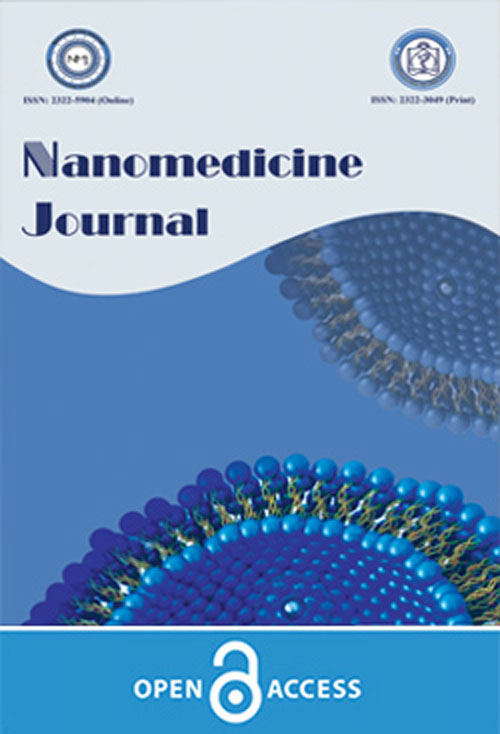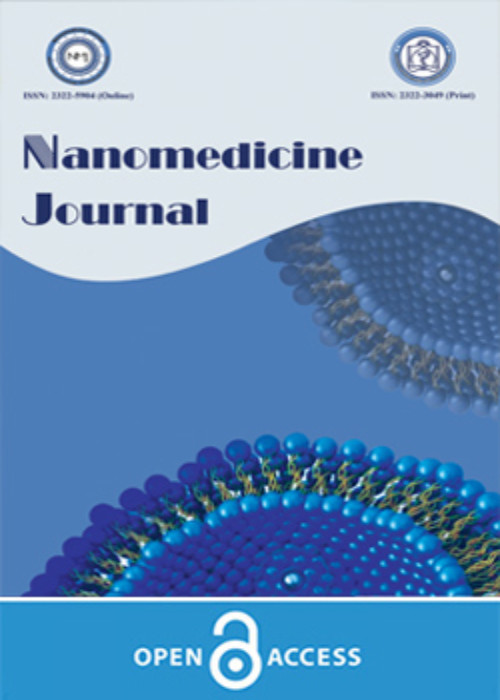فهرست مطالب

Nanomedicine Journal
Volume:3 Issue: 3, Summer 2016
- تاریخ انتشار: 1395/03/25
- تعداد عناوین: 8
-
-
Pages 147-154Nanobiotechnology appears to be an emerging science which leads to new developments in the field of medicine. Importance of the magnetic nanomaterials in biomedical science cannot be overlooked. The most commonly used chemical methods to synthesize drugable magnetic nanobeads are co-precipitation, thermal decomposition and microemulsion. However monodispersion, selection of an appropriate coating material for in vivo application, stability and unique physical properties like size, shape and composition of nanobeads remain unsettled challenge. The use of hazardous reagents during chemical synthesis is another impediment for in vivo application of the magnetic nanobeads. The current minireview put forth the pros and cons of chemical and biological synthesis of magnetic nanobeads. We critically focus on chemical and biological methods of synthesis of the magnetic nanobeads along with their biomedical applications and subsequently suggest a suitable synthetic approach for potential biocompatible nanobeads. Biogenic synthesis is proposed to be the best option which generates biocompatible nanobeads. Reducing enzymes present in plants, plant materials or microbes reduce precursor inorganic salts to nano sized materials. These nanomaterials exhibit biomolecules on their surface. The use of biologically synthesized magnetic nanobeads in diagnostics and therapeutics would be safe for human and ecosystem.Keywords: Bio, synthesis, Biomedical application, Chemical synthesis, Magnetic nanobeads, Nanobiotechnology
-
Pages 155-158This paper provides an overview of how the surface properties of ferromagnetic nanoparticles dispersed in fluids is modified by natural and biocompatible polymers. Among common magnetic nanoparticles, magnetite (Fe3O4) and maghemite (g-Fe203) are popular candidates because of their biocompatibility. Natural polymeric coating materials are the most commonly used biocompatible magnetic nanoparticle coatings. In this paper, recent progresses in the methods of ferrofluids surface modification by the common natural polymers consisting of dextran, chitosan, gelatin and starch are reviewed.Keywords: Biocompatibility, Ferrofluid, Magnetic nanoparticle, Surface modification
-
Pages 159-168Objective(s)Irinotecan is a potent anti-cancer drug from camptothecin group which inhibits topoisomerase I. Recently, biodegradable and biocompatible polymers such as poly lactide-co-glycolides (PLGA) have been considered for the preparation of nanoparticles (NPs).Materials And MethodsIn this study, irinotecan loaded PLGA NPs were fabricated by an emulsification/solvent diffusion method to improve the efficacy of irinotecan. The effect of several parameters on the NPs characteristics was assessed, including the amount of drug and polymer, the amount and volume of the poly vinyl alcohol as a surfactant, and also the internal-phase volume/composition. The irinotecan entrapment efficiency and the particle size distribution were optimized by changing these variables. The cytotoxicity of the particles was evaluated by cell viability assay.ResultsNPs were spherical with a comparatively mono-dispersed size distribution and negative zeta potential. Selected formulation (S9) showed suitable size distribution about120 nm with relative high drug entrapment. MTT assay showed a stronger cytotoxicity of S9 against HT-29 cancer cells than control NPs and irinotecan free drug. The release kinetic indicated Log-Probability model in S9.ConclusionOur results demonstrated that the designed NPs show suitable characteristic and also great potential for further in vivo cancer evaluation.Keywords: Cell culture, Formulation, Irinotecan, Nanotechnology
-
Evaluation of loading efficiency of azelaic acid-chitosan particles using artificial neural networksPages 169-178Objective(s)Chitosan, a biodegradable and cationic polysaccharide with increasing applications in biomedicine, possesses many advantages including mucoadhesivity, biocompatibility, and low-immunogenicity. The aim of this study, was investigating the influence of pH, ratio of azelaic acid/chitosan and molecular weight of chitosan on loading efficiency of azelaic acid in chitosan particles.Materials And MethodsA model was generated using artificial neural networks (ANNs) to study interactions between the inputs and their effects on loading of azelaic acid.ResultsFrom the details of the model, pH showed a reverse effect on the loading efficiency. Also, a certain ratio of drug/chitosan (~ 0.7) provided minimum loading efficiency, while molecular weight of chitosan showed no important effect on loading efficiency.ConclusionIn general, pH and drug/chitosan ratio indicated an effect on loading of the drug. pH was the major factor affecting in determining loading efficiency.Keywords: Azelaic acid, Artificial neural networks (ANNs), Chitosan, Loading efficiency
-
Pages 179-185Objective(s)Silver nanoparticles (Ag-NPs) are one of the most widely used nanomaterials recently. Despite the wide application of nanomaterials, there is limited information concerning their impact on human health and the environment. This study aimed to find the effects of Ag-NPs (40 nm) on blood serum, liver and kidney tissues of homing pigeons (Columbia livia).Materials And MethodsColumba livia, in vivo model used in ecotoxicity experiments were gavaged 3 times daily with 75 and 150 ppm of Ag-NPs within 14 days. A group of 30 Pigeon were randomly divided into three groups: Ag-NPs exposed and control groups (n=10). Data analysis was counducted by performing one-way variance (ANOVA) in SPSS.v.16.0
ResultsThe results of this study illustrated that in the enzyme activity of Glutathione S transferase (GST), Aspartate amino transferase (AST), Alanine amino transferase (ALT) and lactate dehydrogenas (LDH) there is a significant difference between treatment groups with Ag-NPs and the control group. Also, lipid peroxidation (LPO) analysis and catalase activity CAT) suggest Ag-NPs cause the main damage to the liver tissue. On the other hand: Ag-NPs have toxic and harmful effects in both concentrations (75 and 150 ppm), and cause LPO induction, oxidative stress and increase of biomarkers of liver necrosis in under treatment pigeons.ConclusionThe results of this study show that the organisms exposure to Ag-NPs cause toxicity that is dose-dependant. in this study, the highest damage was observed in the liver. However, this issue will have to be considered more extensively in further studies.Keywords: Aspartate amino transferase (AST), Alanine amino transferase (ALT), Oxidative stress biomarkers, Pigeon, Silver nanoparticles (Ag, NPs) -
Pages 186-190Objective(s)In this study, drug loaded electrospun nanofibrous mats were prepared and drug release and mechanism from prepared nanofibers were investigated.Materials And MethodsPaclitaxel (PTX) loaded polylactic acid (PLA) nanofibers were prepared by electrospinning. The effects of process parameters, such as PTX concentration, tip to collector distance, voltage, temperature and flow rate on the mean diameter of electrospun PTX loaded PLA nanofibers were investigated. Scanning electron microscopy (SEM) was used to investigate the fiber morphology and mean fiber diameter of prepared nanofibers. Response surface methodology was used to model the average diameter of electrospun PLA/PTX nanofibers.ResultsThe predicted fiber diameter was in good agreement with the experimental result. In Vitro drug release in phosphate buffer solution (PBS) and acetate buffer for the produced samples showed that diffusion is the dominant drug release mechanism for PTX loaded ubers.ConclusionElectrospinning was shown to be very promising approach to the formulation of Paclitaxel in order to enhance its release in a sustained and prolonged manner.Keywords: Drug Release, Nanofiber, Paclitaxel
-
Pages 191-195Objective(s)A large ratio of surface to volume of nanoparticles in comparison with bulk ones, will increase the cell penetration and therefore their toxicity.Materials And MethodsChemical precipitation method was used in order to synthesis of ZnS:Ag quantum dots. Their Physical properties and characteristics were assessed by X-ray diffraction, Ultra Violet-Visible Spectrophotometer, Transmission Electron Microscope and it was shown that the obtained ZnS:Ag quantum dots are cubic with high-quality. Antibacterial effects of ZnS:Ag nanoparticles against Pseudomonas aeroginosa, Staphylococcus aureus and Salmonella typhi were investigated. Disc bacteriological tests were used in order to assessment of the antibacterial effects of ZnS:Ag nanoparticles.ResultsThe size of inhibition zone was different according to the type of bacteria and the concentrations of ZnS:Ag QDs. The maximum diameter was happened for S. aureus. The results of MICs obtained fromBroth Dilution for Pseudomonas aeruginosa , Staphylococcus aureus and Salmonella typhi, are 3.05 , 3.05 and 6.1 mg/ml whereas the amounts of obtained MBCs are 12.2 , 6.1 and 12.2 mg/ml respectively.ConclusionIn conclusion, by increasing the nanoparticle concentration in wells and discs, the growth inhibition and diameter of inhibition zone has also been increased.Keywords: Antibacterial effect, Pseudomonas aeruginosa, Quantum dots, Staphylococci aureus, Salmonella typhi
-
Pages 196-201Objective(s)According to the unique properties of magnetic nanoparticles, their usages in medicine and industry have increased in the last decade. Due to the vital role of liver in the body, the accumulation of CoFe2O4 and CoFe2O4@DMSA was studied.Materials And MethodsThe nanoparticles were synthesized by co-precipitation method and were coated with DMSA. The techniques XRD, TEM, DLS, FTIR, AGFM and UV-Visible spectroscopy were used to characterize the nanoparticles. Nanoparticles were injected intraperitoneally in rat and blood samples were collected from the rats heart, at 15 and 30 day post injection. The liver of each rat was removed and kept frozen at -70 oC.ResultsThe size of the pure cobalt ferrite and DMSA coated cobalt ferrite nanoparticles were about 10 nm and 12 nm, respectively. The saturation magnetization of CoFe2O4 and CoFe2O4@DMSA nanoparticles were 44.8 and 33 emu/g, respectively. Statistical analysis of the results indicated that cobalt ferrite nanoparticles were accumulated in liver in all groups.ConclusionThe accumulation of nanoparticles in liver was significantly higher than those of the control group and the level of liver iron accumulation was significantly lower after 30 days of injection in comparison with 15 days post injection in all groups.Keywords: CoFe2O4 nanoparticle, DMSA coated, Tissue distribution, Liver, CoFe2O4@DMSA


